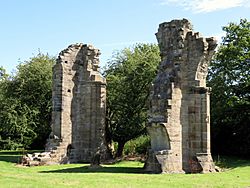Burscough Priory facts for kids

Ruins of Burscough Priory
|
|
| Monastery information | |
|---|---|
| Order | Augustinian |
| Established | c. 1190 |
| Disestablished | 1536 |
| Dedicated to | St Nicholas |
| People | |
| Founder(s) | Robert Fitz-Henry |
| Site | |
| Location | Burscough, Lancashire, England |
| Coordinates | 53°34′59″N 2°51′23″W / 53.5830°N 2.8563°W |
| Grid reference | SD 43409 09944 |
| Visible remains | 2 piers and some foundations |
|
Listed Building – Grade I
|
|
| Official name: Remains of Burscough Priory | |
| Designated: | 11 May 1953 |
| Reference #: | 1196625 |
| Official name: Burscough Augustinian Priory | |
Burscough Priory was an old monastery located in Burscough, Lancashire, England. It was founded around 1190 by a nobleman named Robert Fitz-Henry. This priory was home to a group of monks called Augustinian canons. They followed the rules of Saint Augustine.
The priory was closed down in 1536 during a time when many monasteries in England were shut. Today, only a few parts of the original church building still stand.
Contents
History of Burscough Priory
Burscough Priory was started around the year 1190. Its founder, Robert Fitz-Henry, was the Lord of Lathom. He gave the monks land in Burscough and other nearby areas. He also gave them control over three local churches.
The priory was dedicated to Saint Nicholas. This means it was named in his honor. There was also a special hospital nearby for people with leprosy.
Over time, the ownership of the Lathom lands passed to the Stanley family in 1390. This family became very important. Many members of the Stanley family were buried at Burscough Priory. This included important figures like Sir Thomas Stanley, 1st Baron Stanley.
In 1286, King Edward I of England gave the priory a special permission. This allowed a regular market to be held nearby in Ormskirk. This market still takes place today!
The Priory's Closure
In the 1530s, King Henry VIII decided to close down many monasteries in England. This event is known as the dissolution of the monasteries. Burscough Priory was one of the smaller monasteries. It was closed in February 1536.
At that time, there were only five monks living at the priory. The Earl of Derby, a member of the Stanley family, tried to save the church. He wanted to protect the place where his family members were buried. However, his efforts were not successful.
What Happened to the Bells?
After the priory closed, eight of its bells were moved. They went to Ormskirk Parish Church. The church even had to build a new tower to hold them! The old steeple was not strong enough. Other bells from the priory were moved to Croston church.
One of the bells at Ormskirk Church has a special message. It has a Latin inscription from 1497. It also shows symbols like the rose and the Fleur-de-lis. These symbols suggest that King Henry VII might have visited the priory.
Burscough Priory Today
The name of the priory lives on in the local high school. It is called the Burscough Priory Academy. The school teaches students aged 11 to 16 years old.
What the Priory Looked Like
We know a bit about how the priory church was designed. Surveys done in 1886 helped us understand its layout. The church was shaped like a cross. It had a main area called a chancel, a central tower, and two side sections called transepts. There was also a long main hall called a nave.
On the south side of the nave, there was a cloister. A cloister is an open area, usually a square garden, surrounded by covered walkways. Monks would use this space for quiet walks and meditation.
Remaining Parts of the Priory
Today, only two main parts of the church are still standing above the ground. These are two large stone supports called piers. They were originally part of the central tower of the church. These piers are quite tall.
You can also see some small wall pieces connected to these piers. One of the piers has a small, trefoil-shaped (like a three-leaf clover) alcove. These remaining parts probably date back to the late 1200s.


